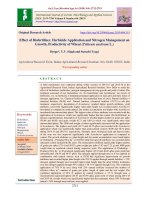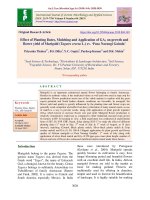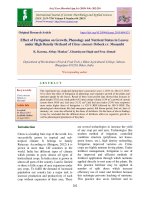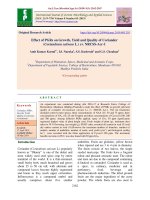To study about effect of sulphur on growth and development on mustard (Brassica juncia L. Czern and Coss.) varieties
Bạn đang xem bản rút gọn của tài liệu. Xem và tải ngay bản đầy đủ của tài liệu tại đây (173.36 KB, 5 trang )
Int.J.Curr.Microbiol.App.Sci (2020) 9(8): 3666-3670
International Journal of Current Microbiology and Applied Sciences
ISSN: 2319-7706 Volume 9 Number 8 (2020)
Journal homepage:
Original Research Article
/>
To Study about Effect of Sulphur on Growth and Development on
Mustard (Brassica juncia L. Czern and Coss.) Varieties
Mukesh Kumar1, Anil Nishad2, Hemant Kumar Sinha3 and Raghuraj Yadav1
1
Department of Agronomy, ANDUA &T Kumarganj, Ayodhya (Uttar Pradesh), India
2
KVK, Singrauli (Madhya Pradesh), India
3
KVK, Chhattarpur (Madhya Pradesh), India
*Corresponding author
ABSTRACT
Keywords
Mustard, Plant
height, Leaf area
index, Dry matter,
Number of branches
per plant
Article Info
Accepted:
26 July 2020
Available Online:
10 August 2020
A field experiment was conducted during the rabi seasons of 2016-17 to assess the
effect of sulphur levels on yield and quality of mustard (Brassica juncea L.). The
experiment was conducted with randomized block design and replicated three
times. Twelve treatment combinations consisted of four sulphur levels viz., 0, 15,
30 and 45 kg S ha-1 and three varieties viz., NDR-8501, Varuna and Maya were
allocated randomly. Results revealed that all the growth, yield attributes and
quality were increased significantly under 45 kg S ha-1. The growth characters
viz., plant height (cm), leaf area index, dry matter accumulation and number of
branches plant-1 and yield attributes like number of siliqua plant-1, number of
seed siliquqa-1, length of siliqua (cm) and seed and stover yields of mustard crop
were significantly higher with Narendra Rai-8501 as compared to Varuna and
Maya.
Introduction
According to area and production both,
mustard stands in second place among oil
seed crops of India. Mustard is grown in
tropical sub-tropical areas of the world. 33.8
% (7.49 million hectare) area of the total
cultivated area of world is in India. 16% of
world total production is produced by India.
Maximum yield of mustard (8.40q/ ha) is
recorded in Jammu and Kashmir (source:
DACNET). The name 'mustard, is derived
from the Latin word mustum, or must of old
wine mixed with crushed seed makes it one of
the most important spice inthe world
(Hemingway 1976). In India, rape seed
mustard is an important source of edible oil
followed by ground nut (pandy er a/ 1999).
They are cultivated in 4.83 million ha in a
wide range of agro- ecological conditions,
resulted in the production of 5.34 million
tones of Rapeseed mustard in 2001 -2002 and
our productivity is 11 06 kg/ha (Anonymous,
2002). In the recent past, the area under
brown mustard is on the increase at the cost of
other Brassicas due to its higher productivity
and tolerance to biotic and abiotic stresses.
The major area is covered by Indian Mustard.
3666
Int.J.Curr.Microbiol.App.Sci (2020) 9(8): 3666-3670
Rapeseed cultivation is confined only to
northern India because of late maturitv and
shattering of pots owing to high temperature
prevailing during harvest in Februarv March(Dutt and Chopra 2OO1). The
information regarding optimum dose of
sulphur and its influence on mustard is
necessary to augement the productivity and
quality of Indian mustard. Sulphur level
significantly influenced the seed and stover
yield of mustard (Sharma et al., 2008).
altitude of 113 meters above mean sea level
and is subjected to extremes of weather
conditions. The experiment was conducted
with randomized block design and replicated
three times. Twelve treatment combinations
consisted of four sulphur levels viz., 0, 15, 30
and 45 kg S ha-1 and three varieties viz.,
NDR-8501, Varuna and Maya were allocated
randomly. The different growth parameters
studied were mustard as.
Results and Discussion
Materials and Methods
The experiment was carried out during rabi
season 2016-17at the Agronomy Research
Farm of the Narendra Deva University of
Agriculture and Technology, Kumarganj,
Faizabad (U.P.) on the topic “To study about
effect of sulphur on growth and development
on mustard (Brassica juncia L. Czern and
Coss.) varieties.” The research farm is
situated at a distance of about 45 km in southeast from Faizabad on Faizabad – Raibareli
road. Geographically, experimental site falls
under the sub-tropical zone and located at
26.470N latitude, 82.120E longitude and an
Plant height increase successively with
increasing sulphur level up to 45 kg S ha-1
significantly. Higher plant height was
recorded under 45 kg sulphur which was at
par at 30 kg S ha-1 and significantly superior
over control and 15 kg S ha-1 at all this crop
growth stages, except 30 DAS (Table 1). Leaf
area index sowing a rapid increase between
30 to 60 DAS has presented in Table no. 2
highest values recorded at 60 DAS.
Thereafter, declined trends were noticed in all
varieties. Active growth lies between 30 and
60 DAS.
Table.1 Plant height of mustard as influenced by sulphur levels and varieties
Treatments
30 DAS
Sulphur levels (kg ha-1)
21.63
0
21.85
15
22.30
30
22.97
45
0.483
SEm±
NS
CD (P=0.05)
Varieties
22.70
NDR -8501
22.21
Varuna
21.66
Maya
0.418
SEm±
NS
CD (P=0.05)
Plant height (cm)
60 DAS
90 DAS
At harvest
64.39
65.76
69.19
71.93
1.304
3.778
123.80
126.28
132.47
137.43
2.749
7.962
150.21
153.10
160.31
166.08
3.911
11.331
75.35
67.86
60.24
1.130
3.272
142.29
128.73
118.96
2.380
6.896
170.62
154.84
146.81
3.387
9.813
3667
Int.J.Curr.Microbiol.App.Sci (2020) 9(8): 3666-3670
Table.2 Leaf area index of mustard as influenced by sulphur levels and varieties
Treatments
Leaf area index
30 DAS
60 DAS
90 DAS
0
1.60
3.87
2.93
15
1.62
4.17
3.15
30
1.65
4.39
3.32
45
1.70
4.56
3.45
S.Em. ±
0.038
0.112
0.070
NS
0.112
0.202
NDR -8501
1.68
4.74
3.58
Varuna
1.64
4.24
3.21
Maya
1.60
3.76
2.84
S.Em. ±
0.033
0.097
0.060
C.D. (p=0.05)
0.096
0.282
0.175
Sulphur levels (kg ha-1)
C.D. (p=0.05)
Varieties
Table.3 Number of branches plant-1 of mustard as influenced by sulphur levels and varieties
Treatments
Number of branches plant-1
30 DAS
60 DAS
90 DAS
At
Sulphur levels (kg ha-1)
0
2.04
14.85
18.72
18.35
15
2.06
16.01
20.18
19.77
30
2.10
16.83
21.22
20.79
45
2.16
17.49
22.05
21.61
S.Em. ±
0.047
0.393
0.475
0.447
C.D. (p=0.05)
0.135
1.139
1.375
1.295
NDR -8501
2.13
18.10
22.82
22.37
Varuna
2.09
16.30
20.55
20.14
Maya
2.04
14.47
18.25
17.88
S.Em. ±
0.040
0.340
0.411
0.387
C.D. (p=0.05)
0.117
0.986
1.191
1.122
Varieties
3668
Int.J.Curr.Microbiol.App.Sci (2020) 9(8): 3666-3670
Table.4 Dry matter accumulation as influenced by sulphur levels and varieties
Treatments
Dry matter accumulation (g plant-1)
30 DAS
60 DAS
90 DAS
At harvest
Sulphur levels (kg ha-1)
1.70
13.59
30.33
35.15
0
1.72
14.65
32.69
37.88
15
1.75
15.40
34.37
39.83
30
1.80
16.01
35.72
41.39
45
0.035
0.349
0.704
0.871
S.Em. ±
0.035
1.010
2.039
2.522
C.D. (p=0.05)
Varieties
1.78
16.57
36.98
42.85
NDR -8501
1.75
14.92
33.29
38.58
Varuna
1.70
13.25
29.56
34.26
Maya
0.031
0.302
0.609
0.754
S.Em. ±
0.088
0.875
0.609
2.184
C.D. (p=0.05)
Leaf area index increased with increase in
dose of sulphur up to 45 kg S ha-1 at 30, 60
and 90 DAS of mustard crop. 45 kg S ha-1
significantly increase leaf area index at all
growth stages, except at 30 DAS. Data
pertaining to number of branches plant-1 of
mustard as affected by sulphur levels and
varieties recorded at successive growth stages
have been presented in Table no. 3. Number
of branches plant-1 increased with increasing
sulphur levels. Highest number of branches
plant-1 was recorded with at 45 kg S ha-1
which was at par at 30 kg S ha-1 and
significantly higher over control and 15 kg S
ha-at all the stages of crop growth, except at
30 DAS. Maximum number of branches
plant-1 was recorded by NDR-8501 which
was significantly higher over Varuna and
Maya at all the growth stages of crop growth,
except at 30 DAS. Dry matter accumulation
plant-1 increased significantly with increase
in dose of sulphur up to 45 kg S ha-1 at 30,
60, 90 DAS and harvest stage of mustard
crop, which was par at 30 kg S ha-1 and
significantly superior over control and 15 kg
S ha-1 at all growth stages of crop growth,
except 30 DAS (Table 4). The interaction
effect between different levels of sulphur and
varieties on dry matter accumulation plant-1
was found non-significant at all the stages of
crop growth. Among the varieties NDR-8501
recorded significantly higher dry matter
accumulation at 60, 90 DAS and at harvest as
compared to Varuna and Maya, respectively.
In conclusion different levels of sulphur
application significantly influenced plant
height at 60, 90 DAS and at harvest.
Application of 45 kg S ha-1 resulted in
significantly higher plant height at 60, 90
DAS and harvest (71.93, 137.43 and 166.08
cm respectively) but it was statistically at par
with 30 kg S ha-1 and significantly superior
over control and 15 kg S ha-1. Application of
45 kg S ha-1 produced significantly higher
number of branches plant-1 but statistically at
par with 30 kg S ha-1 and significantly
superior over control and 15 kg S ha-1. The
leaf area index significantly increased with
the variety NDR-8501 at all the growth stages
of crop, except 30 DAS over the remaining
varieties (Varuna and Maya). The maximum
dry matter accumulation plant-1 was recorded
with variety NDR-8501 which was
3669
Int.J.Curr.Microbiol.App.Sci (2020) 9(8): 3666-3670
significantly higher than Varuna and Maya at
all growth stages, except 30 DAS. The
maximum branches plant-1 was recorded by
variety NDR-8501 which was significantly
higher over Varuna and Maya, at all growth
stages, except 30 DAS.
References
Sharma, R., Dahiya, S.S., Yadav, H.D. and
Singh, M.(2008). Effect of sulphur
application on yield attributes, yield, S
uptake and oil content of Indian
mustard (Brassica juncea L.). Haryana
Agricultural University, Journal of
Research, 35 (2): 135-138.
Anonymous 2002. Agriculture statistics at a
glance, Government of India, New
Delhi, pp 100-101.
Panday. I.D, Basudeo Singh and J.N. Sachan
1999. Brassica Hybrid research in
India: status and prospects. Proceedings
of the tenth international rape seed
congress. Canberra, Australia.
Hemingway, J.S. 1976. Mustards in Evolution
of Crop plants, Ed. N.W. Summonds
Longman, London of New York.
Dutt B. K. and N. K. Chopra 2O01. Improved
technology in mustard threshing Indian
Farming: 7:14-15 Hemingway, J.S.
1976.
How to cite this article:
Mukesh Kumar, Anil Nishad, Hemant Kumar Sinha and Raghuraj Yadav. 2020. To Study
about Effect of Sulphur on Growth and Development on Mustard (Brassica juncia L. Czern
and Coss.) Varieties. Int.J.Curr.Microbiol.App.Sci. 9(08): 3666-3670.
doi: />
3670



![Effect of different plant growth regulators on shooting of stem cuttings in dragon fruit [Hylocereus undatus (Haworth) Britton & Rose]](https://media.store123doc.com/images/document/2020_01/09/medium_isb1578564896.jpg)





